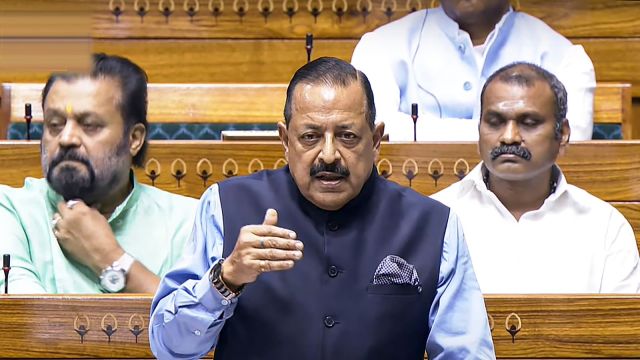First Isro-Nasa collaboration satellite NISAR will be ‘gamechanger’ in disaster monitoring and response, minister Jitendra Singh tells Lok Sabha
There has been a quantum jump in space startups and space economy in India over the last few years, Jitendra Singh said during the Monsoon Session of Parliament.
 Minister of State Jitendra Singh speaks in the Lok Sabha during the Monsoon session of Parliament, in New Delhi, (Photo/PTI)
Minister of State Jitendra Singh speaks in the Lok Sabha during the Monsoon session of Parliament, in New Delhi, (Photo/PTI)Union Minister of State for Science and Technology (Independent Charge) Jitendra Singh told Lok Sabha Wednesday that earth observation satellite NISAR (Nasa-Isro Synthetic Aperture Radar) will be a “gamechanger” in disaster monitoring and response. He added that the first collaboration satellite of Indian Space Research Organisation (Isro) and the United State’s National Aeronautics and Space Administration (Nasa) will lead to better prediction of landslides, volcanoes and cyclones.
“It will also have the capacity to penetrate through fog, through heavy clouds and also dense ice layers, which would provide us much more ease not only in the disaster management sector but also in a host of other sectors like the aviation sector, shipping transport, etc.,” Singh said during the Question Hour in the Monsoon Session of Parliament.
NISAR, which has been in the making for more than one and a half decades, will be launched from the Satish Dhawan Space Centre at Sriharikota in Andhra Pradesh at 5.40 pm Wednesday. Once deployed, this satellite will be the most powerful earth observation satellite in space, capable of producing data and high-resolution images that will support research across a variety of fields. It is the first satellite equipped with two Synthetic Aperture Radars (SARs) operating in different frequency bands, marking a significant technological achievement that enhances its capabilities. Also, it is the most expensive satellite ever built.
In Lok Sabha, Singh was replying to a question by Trinamool Congress (TMC) Jaynagar MP Pratima Mandal regarding the various schemes implemented through space technology throughout the country, as well as the technological achievements of the Gaganyaan mission, the country’s human spaceflight programme, and the requirements for astronaut safety.







